January Puzzling Phenomenon:
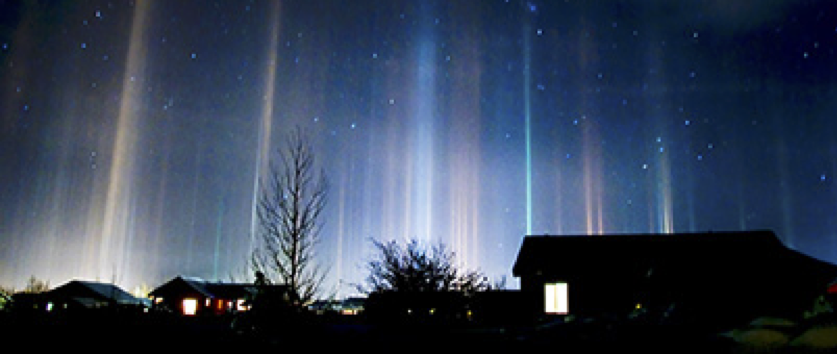
Developed by Nicole Gerardo, January 2017
Title: Light Beam Me Up? – The Puzzle of Light Pillars
Concept: Waves/Optics & Weather
Introduction and Phenomenon:
Over Winter break, I always look forward to the stories that my “interesting” Uncle Ed brings to the table. This year he is adamant he has experienced a close encounter of the 4th kind, as in he was beamed up, … onto an alien spacecraft. I listen intently to the outlandish details of his tale with amusement in my heart. “How does he come up with these stories?” I wonder for a moment. Soon after my thoughts are ready to move on past the tall tale, and I go to get up from the table. I am quickly stopped by a cry from Uncle Ed, who knows I am the scientific skeptic of the family. “Wait! I have proof!” he proclaims. He hands me a picture, and for a moment I am baffled. Pillars of light are shooting straight up from the rooftops of the houses in a little town, rising up to meet some unknown destination in the night sky.
Is the entire population of this town being beamed up as Uncle Ed is claiming? Or can you help me delve deeper into some science to help set him straight?
My “Uncle Ed” has indeed been deceived by a scientific phenomenon that is actually an optical illusion know as light pillars, or sometimes sun pillars. You can find a number of pictures of this phenomenon online, choose whichever you like, and tailor the story to fit the interests and curiosity of your students.
Explanation of the science involved:
The pillars seen in the photo above represent a phenomenon know as light pillars. These pillars are most often seen in polar regions and/or during winter months because it is the presence of ice crystals in the atmosphere that allows this phenomenon to be witnessed. As seen in the picture below, the pillars appear when light from the source is reflected back down to spectators’ eyes by the flat facets of these plate-shaped ice crystals. What makes this phenomenon even more intriguing is that it is really an optical illusion. There is not really a pillar of light rising up from the light source. The crystals just happened to be lined up in an arrangement that collects some of the light and reflects only those light rays toward your eyes, fooling you into thinking there is a beam there.
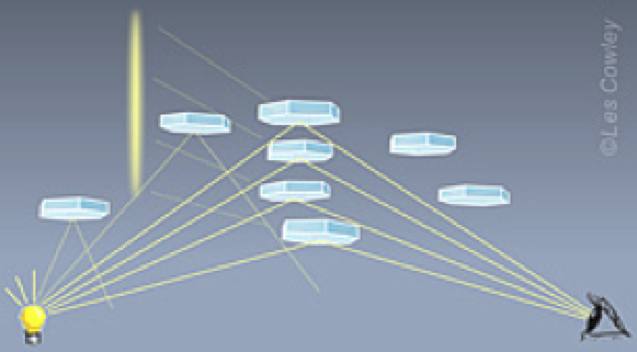
The pillars can originate from artificial light sources, as in the picture below on the left, and are then know as light pillars. They can also originate from natural sources of light, as in the picture on the right, which is referred to as a sun pillar. I even saw some interesting examples of pillars originating from the light reflected off the moon and even planets, so there are a wide variety of examples to spark the interest of your students.
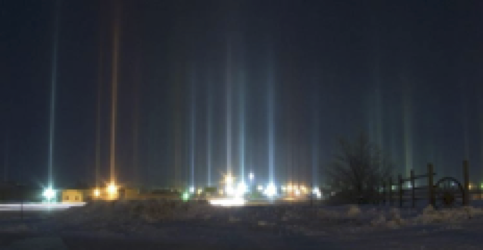
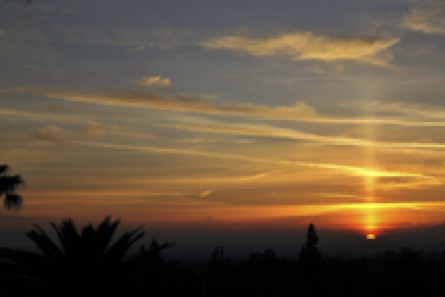
Further Ideas for Classroom Use:
This puzzling phenomenon could be used during a physical science unit on waves, specifically as part of the topic of light behavior/optics. I think the placement of this mystery would best fit after students have had plenty of time to explore the behavior of light in regard to the Law of Reflection. Some great STEM activities from California State University found at the link below could spark some ideas of how to get the exploration of reflection started.
Link: http://web.csulb.edu/~lhenriqu/ReflectionsOnLight.pdf
In the activities described in the linked PDF, students get the chance to explore with a flashlight, mirror, and construction paper to discover where to place the construction paper in order to “catch” the beam of light from the flashlight that they reflect off the mirror. This resource works up to some great extension activities that have students making predictions about where a light beam will end up after being reflected through a series of differently arranged mirrors. These activities also provide opportunities to incorporate math into student analysis by have students calculate, propose, and/or predict angle measurements in various scenarios.
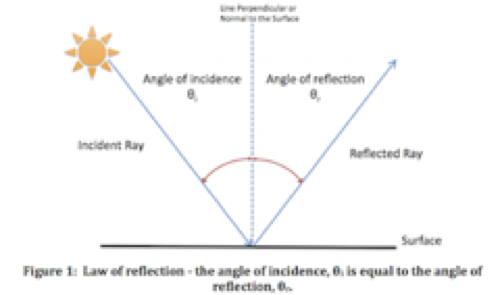
Once students have a thorough grasp of light behavior from their explorations, the puzzling phenomenon of light pillars can be a great example of a mystery that students can apply this knowledge to in order to solve.
After presenting the original picture, I would ask students to start with individual brainstorming using some Starting Question and move to working in small groups to create explanatory models of how they think the light pillars came to be. You could provide scaffolding in the form of a progression of or clues that will help students on their path of discovery and development of their explanatory models. Student groups should edit and add to their models as they are presented with additional information in the clues, working towards a final explanatory model.
Starting Questions
- What do you observe in the picture? Describe in detail.
- What unseen factors might be contributing to what you observe?
- How might this situation relate to the activities we have done in this unit?
Sample Clue Progression
- Clue 1: No spotlights are at work in this situation. (This will help prompt students to look for a more complex explanation than an intentional upward facing beam of light.)
- Clue 2: Provide data about weather conditions and/or location of light pillar incidences. (The goal would be for students to realize that this phenomenon is common under cold conditions, which hopefully will prompt them to think about what might be present in the atmosphere that they can’t see.)
- Clue 3: Ask students to reference a diagram of the law of reflection, such as the one above, and try to figure out how the parts in the diagram might be at work in the novel situation.
Final Model Gotta-Haves
These are some gotta-haves that students should be able to explain and depict in the final examples of their group-created models:
1. What can be observed in the photograph? Describe important elements.
(Students should be able to depict the light source and the observed beam.)
2. What unseen factors are working to cause this phenomenon?
(Students should be able to identify the unseen surface of reflection, the ice crystals. Students should also depict the observer that is necessary to view the beam.)
3. What interactions occur between what is seen and unseen to produce the light pillar?)
(Students should be able to describe and depict how light beams from the source
interact with the light crystals in order to produce the beam seen by the observer.)
Student groups may not need as many clues to get on the right track, or, conversely, they might need some additional guidance that you could craft as needed. One of the most important goals would be to have students figure out, as independently as they can, that there must be a light source, some reflective surface present in the atmosphere, and an observer to receive and view the pillar. More sophisticated student groups may be able to figure out that there must be multiple reflective surfaces in order to produce a beam and not just a spot of light like in their flashlight activity.
You could even present your students will an extension challenge in which you describe another observer in a different location who does not see the pillar of light, but only sees the light extending in all directions from the source. Students would then be challenged to explain the position of two observers more specifically in relation to angles of reflection.
Ideally this phenomenon could be used in a class with an integrated science curriculum, so that previously explored weather concepts could also be integrated and reviewed as part of this mystery activity. If your class is limited to physical science, weather concepts could still be integrated but probably kept at a simpler level of understanding.
Download this month's Scientific Phenomenon as a Word Document here.


